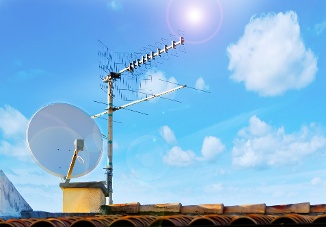Satellite dishes and antennas can be a point of contention in community associations. Viewed by some as an unwanted deviation from the uniform appearance of the community, satellite dishes and antennas may offer cost-savings or enhanced programming options deemed essential to sports fanatics. Those who purchase a unit in a community buy subject to the Master Deed and other governing documents and thus give up certain rights in order to maintain the community’s established standards for landscaping and style. Nevertheless, satellites and antennas are one community issue where federal law also plays a role.
Under what circumstances can members of a community association install a satellite dish or antenna? The short answer is when the satellite or antenna is installed on the homeowner’s own property, but exactly where and how this equipment can be mounted may depend on the type of community (homeowners association versus condominium association or cooperative) and the additional restrictions put in place.
Federal law provides that a resident of a community association has the right to install a satellite dish on property the resident owns or rents or that is assigned for the person’s exclusive use (limited common elements such as patios). Communities can prohibit installation of satellite dishes and antennas in or on common elements or common property.
Section 207 of the Telecommunications Act required the Federal Communications Commission (“FCC”) to adopt rules for the installation of satellite dishes in community associations. The official name of the FCC’s rule is the Over-the-Air-Reception Device (“OTARD”) Rule.
A person’s right to install a dish in certain areas of the community can be regulated, within reason, as defined by the FCC. Association rules that impair a person’s ability to install, maintain, or use a satellite dish are prohibited. A restriction impairs if it: (1) unreasonably delays or prevents use; (2) unreasonably increases the cost; or (3) precludes a person from receiving an acceptable quality signal from a satellite dish.
Q: What types of antennas are covered under the OTARD rules?
A: The following antennas or dishes are covered by these rules:
- A “dish” antenna one meter (39.37 inches) or less in diameter (or any size dish if located in Alaska), designed to receive direct broadcast satellite service, including direct-to-home satellite service, or to receive or transmit fixed wireless signals via satellite.
- An antenna that is one meter or less in diameter and is designed to receive video programming services via broadband radio service (wireless cable), or to receive or transmit fixed wireless signals other than via satellite.
- An antenna that is designed to receive local television broadcast signals.
Antennas used for AM/FM radio, amateur (“ham”) radio, CB radio, Digital Audio Radio Services (“DARS”) or antennas used as part of a hub to relay signals among multiple locations are not covered by these rules. However, there is legislation pending which, if enacted, may invalidate many community association rules and architectural standards governing the installation and use of amateur radio towers and antennas.
Q: Are homeowners associations required to permit satellite dish installations?
A: Yes, if the owner owns or has the exclusive use of the whole house or lot, including the walls and the roof, the FCC requires an association to permit satellite dishes. The owner is able to put a satellite dish on his/her roof, exterior walls, or backyard. This is true even if the association maintains the roof or other exterior areas of the home or lot.
Q: Can a satellite dish be installed in/on common elements in a condominium association?
A: The OTARD Rule does not require an association to permit the installation of a satellite dish on a common element, such as a walkway, hallway, community garden, common element exterior wall or roof. Board approval is required to install a satellite dish in common areas. Drilling through a common element exterior wall is generally not permitted because the exterior wall is typically a condominium common element.
Q: Can a board can require a resident to provide a “notice” of his/her intent to install a dish?
A: Yes, but the board may not require the resident to wait for board approval before proceeding, as prior approval would constitute an “unreasonable delay.”
Q: Can the association require a satellite dish installation fee?
A: No. A requirement to pay a fee to the association for a permit to install a satellite dish is prohibited.
Q: Is the association allowed to make satellite dish rules or installation guidelines?
A: Yes, clearly defined, legitimate safety rules are permitted, such as fire code compliance or and installation rules that describe the proper method to secure a satellite dish. A board may also adopt installation guidelines that include permissible installation locations, screening and maintenance requirements, height restrictions, and indemnification requirements that limit the association’s potential liability for damage to or from a satellite dish installation, but these types of guidelines and requirements must be adopted and put in place before a resident installs a satellite dish.
Q: What if a resident cannot receive signals because the association’s trees are in the way? Does the OTARD Rule require the association to maintain those trees?
A: No. The Rule does not place any affirmative obligation on associations to assist homeowners in receiving signals. The FCC only preempts restrictions on access to adequate signal reception.















